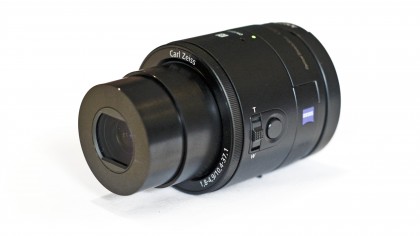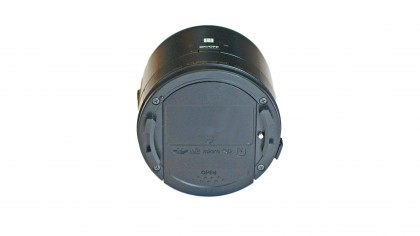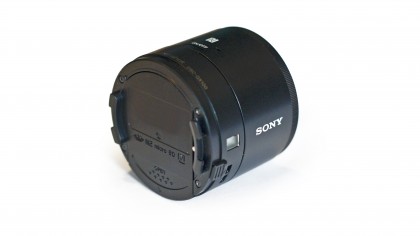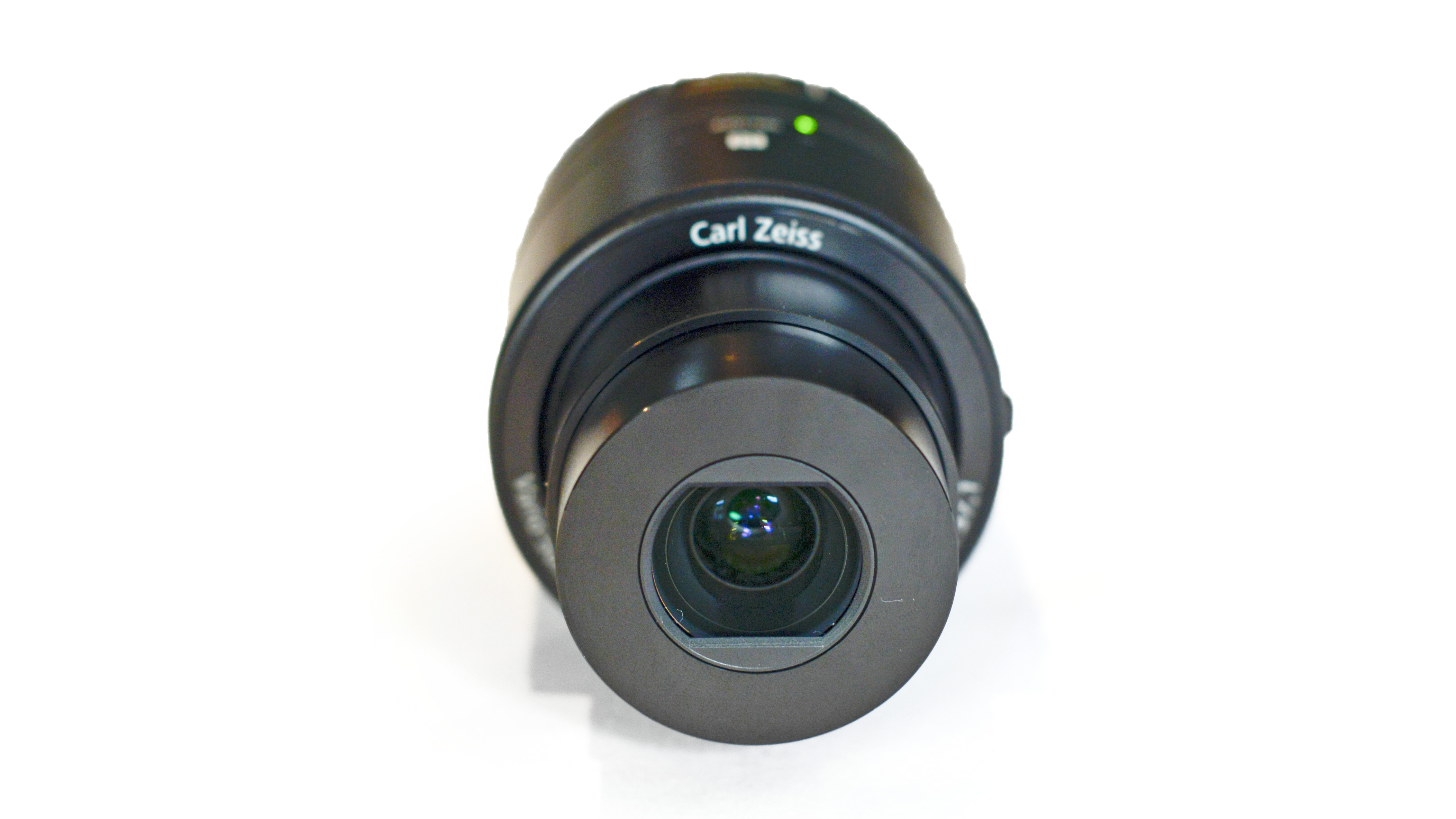Why you can trust TechRadar
The basic point and shoot compact camera market seems to be fighting a losing battle against the rise of the always-ready smartphones. What Sony is attempting to do with its two new QX cameras is create a hybrid of the two, rather than trying (and failing) to compete.
What we have with the Sony QX100 (and its sibling, the Sony QX10) is all the elements of a compact camera contained within something that's the same size as a small interchangeable lens. So, not only do you have the lens itself, you also have the sensor, image processor and memory card. You don't, however, get a screen - because you don't need one, that's what your smartphone or tablet is for.
Cameras such as the Canon PowerShot N were developed to be a companion to the smartphone/tablet, but it could of course be used as a camera in its own right. The Sony QX range takes that idea to the next level, relying solely on your smart device to operate it.

Sony, not being a traditional imaging company, has taken to innovation for its USP. Its massive R&D department means that it can put a lot of energy into developing new products. We've already seen what it's capable of in recent times with the introduction of the Sony RX1 - a compact camera with a full-frame sensor - and the Sony RX100 (and more recently the Sony RX1-R and Sony RX100 II), a compact camera with a one-inch sensor.
The Sony QX100 is the more expensive of the two Sony QX options, and essentially is a slightly more basic form of the premium Sony RX100 II. It has the same one-inch 20.2 million pixel sensor, Bionz processor and 3.6x optical zoom lens. It doesn't, of course, have the rear screen.
To use the camera with your phone or tablet, the device is both Wi-Fi and NFC connectable. The good news is that it's compatible with Android, iOS and Amazon Kindle devices, so you're not just limited to Sony's own products. You will need to download the Sony PlayMemories app to use the camera, though.

Although the camera has a slot for a microSD card, you can also choose for every shot to be transferred across to your phone, either at the camera's standard resolution or at a lower resolution that's more suitable for sharing on social networks and the like.
Sign up for breaking news, reviews, opinion, top tech deals, and more.
You could also use the camera on its own without a smartphone or tablet, but of course you wouldn't know exactly what was in frame and you wouldn't be able to control any of the settings.
This isn't exactly a cheap option for now, with the Sony QX100 having an estimated retail price of around £399 (around US$630 / AU$690). But, bearing in mind that the Sony RX100 Mark II where it takes its core elements from costs £650 / US$750 / AU$770, it's arguably a more reasonable offering. For those looking for something a bit more budget-friendly, the Sony QX100 features a smaller sensor (but a larger zoom) and a more modest price tag.
Build quality and handling

As previously mentioned, the Sony QX100 is roughly the same size as a small interchangeable lens, for instance something from Sony's own NEX range. It's also circular, like a lens, so you'd be forgiven for mistaking it for something rather ordinary at first glance.
When switched on, the Sony QX100's lens protrudes quite far from the body, but when powered off, the camera could fit into a jacket pocket, if not being quite small enough to fit into a jeans pocket.
In terms of physical buttons, you won't find too many on the Sony QX100 since most of the operation is carried out via whatever you attach it to. There's an on-off switch and a zoom lever and a shutter release button. You can choose to either use the button or release it via the app itself, depending on how you want to hold the camera/lens combination.

Because the camera doesn't have to be physically attached to your phone, you can use it entirely separately. With a range of around 10 metres, you can even stand in a different room and operate the camera, which could make for some fun party shots.
Although there's no LCD screen for composing shots, there is a very small display for showing remaining battery life. Other than that, you'll rely almost entirely on the PlayMemories app for shooting images and changing settings, such as aperture and exposure compensation.
This isn't the camera for people who like physical buttons. Once pairing the camera with a smartphone or tablet, it's akin to using a camera entirely with a touchscreen. There is at least a physical shutter button on the lens itself to give you that feeling that you're using a 'real' camera. Or you can also use a shutter release icon on the phone/tablet if you prefer.

The Sony QX100 has a 3.6x optical zoom, which can be activated via the touchscreen, but if you prefer there is also a zoom switch on the camera unit itself, which is particularly useful if you're holding the lens separately to the screen you're working with (or of course you just prefer a physical switch).
Zooming seems quick and fluid, and of course having an optical zoom will elevate your zoomed shots above the digital technologies that most camera phones are equipped with.
At the back of the camera you'll find a slot for a microSD card. This means you can save images directly to the card, or save to both the card and your phone. You can also set it to record full resolution files to the card for use later, and lower resolution files to the phone for sharing easily on social networks and online, which is a useful function. Unlike the Sony RX100 II though, the Sony QX100 cannot shoot in raw format.
Performance

Of course it's always difficult to judge the image quality of a camera when testing a pre-production sample. However, we can be relatively assured of image quality in this case, since the image sensor and processor are the same as those found on the excellent Sony RX100 Mk II.
As every element of the image making - the sensor, processor and lens - is coming from the older camera itself and the smart device used to control is just a conduit through which to use it, there should be no impact on image quality itself. But of course we'll be keen to put that fully to the test.
It's a shame that the Sony QX100 can't shoot in raw format, like its Sony RX100 II sibling. Sony says that this is because phones and tablets can't read raw format images, but since the camera has a memory card slot, it could have saved raw files to that for working on later, leaving JPEGs for the phone.

Perhaps it's something that Sony will consider for future versions of the Sony QX cameras, if it proves to be a requested feature.
Speed of operation and autofocusing will be interesting to test when we get a final production camera in for our full review, since this is likely to be dependent on the speed of the phone or tablet you're using. We'll be keen to test it with a variety of different devices to see how it compares.
Initial verdict
Sony has once again come up with an innovative concept in the Sony QX100. For some time, camera manufacturers have been struggling to keep up with the onslaught of improving camera phone technologies. This is the first time we're seeing something which directly works with a phone, rather than trying to beat it.
We've got to say we're intrigued. Something that you can easily fit in your pocket and quickly attach to your phone for decent photos is a very appealing prospect, but there are, of course, some caveats. We know how much of a drain constantly taking photos with your phone can be on battery life, and adding a more powerful camera to the device is unlikely to help that.
We'll also be interested to see how the downloadable app works, and whether it quickly becomes frustrating having very few physical buttons.
It's very likely that the Sony QX100's image quality will be very good, since we've already seen the sensor and processor performing well elsewhere, so we'll be looking forward to seeing how it matches up.
Stay tuned for a more comprehensive review of the Sony QX100 when a final sample becomes available for testing.

Amy has been writing about cameras, photography and associated tech since 2009. Amy was once part of the photography testing team for Future Publishing working across TechRadar, Digital Camera, PhotoPlus, N Photo and Photography Week. For her photography, she has won awards and has been exhibited. She often partakes in unusual projects - including one intense year where she used a different camera every single day. Amy is currently the Features Editor at Amateur Photographer magazine, and in her increasingly little spare time works across a number of high-profile publications including Wired, Stuff, Digital Camera World, Expert Reviews, and just a little off-tangent, PetsRadar.
What is a hands on review?
Hands on reviews' are a journalist's first impressions of a piece of kit based on spending some time with it. It may be just a few moments, or a few hours. The important thing is we have been able to play with it ourselves and can give you some sense of what it's like to use, even if it's only an embryonic view. For more information, see TechRadar's Reviews Guarantee.
